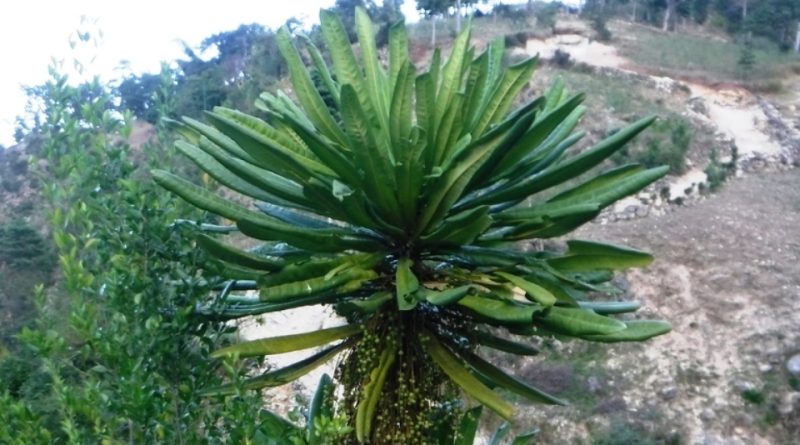Clavija domingensis
Clavija domingensis
The lengua de buey (Clavija domingensis Urb. & Ekman, 1929) is a shrub species belonging to the Primulaceae family.
Systematics –
From a systematic point of view it belongs to:
Eukaryota domain,
Kingdom Plantae,
Magnoliophyta division,
Class Magnoliopsida,
Order Primulales,
Primulaceae family,
Subfamily Theophrastoideae,
Theophrasteae tribe,
Genus Clavija,
Species C. domingensis.
Etymology –
The term Clavija was given in honor of José de Viera y Clavijo (December 28, 1731 – February 21, 1813), Spanish, of Portuguese origin, Enlightenment clergyman, poet, historian, botanist, ethnographer and professor.
The specific epithet domingensis comes from the Latin domingensis, of Domingo, referring to the capital of the Dominican Republic, Santo Domingo, where many specimens are found in the National Botanical Garden.
Geographic Distribution and Habitat –
Clavija domingensis is a plant endemic to Haiti, in the Caribbean Sea, where it grows on the Massif de la Hotte, in the area of the southwestern peninsula.
Its habitat is that of the semi-arid bush, where it grows on calcareous soils, between 250 and 500 m above sea level. It is a very rare species in its natural state, where it is reduced to a few tens of specimens, and even more in cultivation, present outside its place of origin only in a few botanical gardens and private collections.
Description –
Clavija domingensis is an unbranched shrub that grows up to 4 – 8 meters in height.
The stem has a diameter of 20-30 cm and the bark is wrinkled, slightly furrowed longitudinally, of a brown-grey colour.
The leaves are long, on a 2-5 cm long petiole, lanceolate, simple, spatulate and coriaceous; they have a rounded apex, an entire margin and a prominent central rib on the lower page; the dimensions are 0,8-1,10 m long and 9-15 cm broad, of an intense green color and glossy above and opaque below. The leaves grow from the top of the trunk, giving the plant the appearance of a palm tree.
Flowers and fruits are born on long hanging racemes.
The inflorescences are 50-65 cm long hanging racemes under the crown; these carry numerous flowers, of about 1,5 cm of diameter, which open in succession; the calyx has 5 ovate lobes, the corolla is crateriform with 5 oblong to orbicular shaped petals, fleshy, of a vivid orange colour; it has 5 stamens, a unilocular ovary and a short style.
The fruits are globose berries, of about 1,5 cm of diameter; these are initially green, then orange when ripe.
Inside there are a few globular seeds, immersed in a fleshy pulp with a pleasant taste.
Cultivation –
The Clavija domingensis is a plant that recalls, due to the arrangement of the leaves, a palm, with a particular elegance due to the erect stem, the thick crown and the colored inflorescences.
This plant is very slow growing; for its cultivation it needs a tropical or subtropical climate, as it does not bear temperatures just under the +5 °C, even if exceptional and short-lasting.
From the pedological point of view it can also be cultivated on poor soils and tolerates short periods of drought if already mature and well rooted; however, it grows much better in rich, draining soils that are frequently irrigated in times of drought.
Reproduction occurs by seed; this is to be placed in a draining substratum and kept constantly humid at a temperature of 24-26 °C; under these conditions, germination begins after 2-3 weeks.
Customs and Traditions –
Clavija domingensis is a plant known by various names; among these we remember: Haiti Clavija (in English); bwa jan louwi, grand kokmolye, lang bèf (in Haitian Creole); bois Jean Louis, grand coque mollier, langue a boeuf, langue de boeuf (in French); lengua de buey (in Spanish).
The long leathery leaves of this plant inspired the plant’s Haitian Creole name: lang bèf (literally «cow’s tongue»).
This plant, as a result of the extremely small number of specimens (a few dozen plants, dispersed and fragmented) is in constant decline, both due to the expansion of agriculture and the indiscriminate cutting of the forest.
For this reason this species has been inserted in the red list of the IUCN as “Critically Endangered” (at very high risk of extinction in the wild in the immediate future).
Method of Preparation –
Clavija domingensis is a plant which, although potentially usable in the food field, is not suitable for this purpose due to the small number of its specimens.
Guido Bissanti
Sources
– Acta Plantarum – Flora of the Italian Regions.
– Wikipedia, the free encyclopedia.
– GBIF, the Global Biodiversity Information Facility.
– Useful Tropical Plants Database.
– Conti F., Abbate G., Alessandrini A., Blasi C. (ed.), 2005. An annotated checklist of the Italian vascular flora, Palombi Editore.
– Pignatti S., 1982. Flora of Italy, Edagricole, Bologna.
– Treben M., 2000. Health from the Lord’s Pharmacy, Advice and experiences with medicinal herbs, Ennsthaler Editore.
Photo source:
– https://inaturalist-open-data.s3.amazonaws.com/photos/168588076/original.jpeg
– https://s3.amazonaws.com/huhwebimages/35423380B96A49B/type/full/73634.jpg
Attention: The pharmaceutical applications and alimurgical uses are indicated for informational purposes only, they do not in any way represent a medical prescription; we therefore decline all responsibility for their use for curative, aesthetic or food purposes.


